Last time, I discussed what I perceive as a problem in the way that most open world games (specifically, sandbox games) design their maps and use the space that the maps offer - or fail to use that space, to be more specific. So many open world maps end up feeling less like actually playing the game, and more like a convoluted mission-select and collectible checklist screens. This problem is especially bad in the Ubisoft model of design, and is also a problem (to a lesser extent) in Bethesda's open worlds. Due to the popularity of these developers' franchises, many other developers have been cloning these styles of games to one extent or the other, to the point at which Ubisoft's open world model seems to be the go-to template for any developer trying to make an open world game. These games aren't necessarily bad. They just aren't very good at making the space of their maps feel meaningful in its own right.
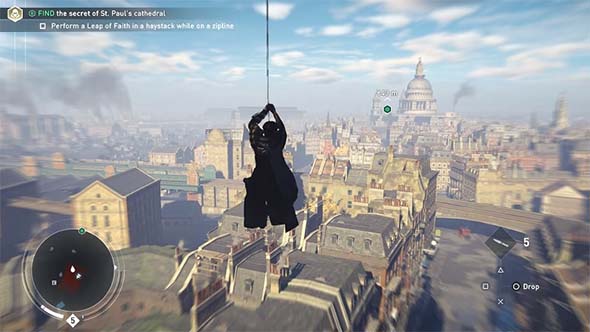
Many open world games have large, expansive maps that mostly feel empty and pointless,
as the player rushes through them simply to get to the next map marker or checklist item.
But now that I've established what I see as a problem, I want to focus on positive feedback. In this discussion, I'm going to look at a handful of games that should serve as inspirations for would-be open world developers. Ironically, some of these games aren't even open world games, but they still pose valuable lessons for how games that are open world could better use their game spaces. That isn't to say that the games discussed here are perfect. In fact, many of them have their own major flaws. But each of them has some element of design that utilizes the actual game map as a component of active play, rather than just a space in which game sequences exist. First, let's take a look at a game that was re-made recently, and use it as a "before and after" case study of map design... [More]
75d0658b-0278-43f3-a9e5-d3df3d01939d|4|4.3
Tags:open world, map, traversal, travel, cartography, geography, narrative, ludonarrative, ludonarrative dissonance, quest, vehicle, driving, racing, exploration, wasteland, survival, resources, Ubisoft, Bethesda, Resident Evil, Metal Gear Solid V: the Phantom Pain, Assassin's Creed, The Elder Scrolls, Skyrim, The Witcher 3, Grand Theft Auto, Grand Theft Auto V, Grand Theft Auto: San Andreas, Shadow of Mordor, Fallout, Fallout: New Vegas, Wasteland 2, Mad Max, Miasmata, Assassin's Creed IV: Black Flag, Burnout: Paradise, Shadow of the Colossus, Dark Souls
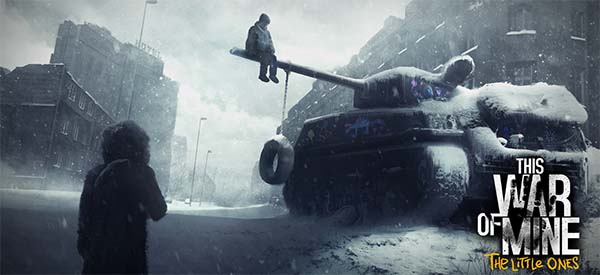
It was a long wait to get this DLC on PC and Steam. It originally released back in January on consoles, while we early adopters of the PC version were stuck waiting out in the cold with no clue whether or not we'd ever get the expansion. I wanted to play it, but I was hoping that a PC version would be released because I was skeptical that controlling a shelter full of characters with only an analog stick (and no pause button) would be unweildy. But it finally did get a release on Steam, and was even discounted during the Steam Summer Sale, so there was no way that I was going to pass that up.
The base version of This War of Mine is a fantastic game and ranks up there with Papers, Please, Metal Gear Solid 3, and Ace Combat 4 as one of the best games about war that I've ever played. This War of Mine is a very harsh, brutal, and depressing game. But if you didn't think that it was a depressing enough game to begin with, then wait till you play it with children as playable characters! The expansion adds some new scenarios with child characters as well as a handful of child-specific craftable items, but it's surprisingly skimpy on new content. As far as I can tell, there are no new scavenge locations, ambient events, or neighbor events.
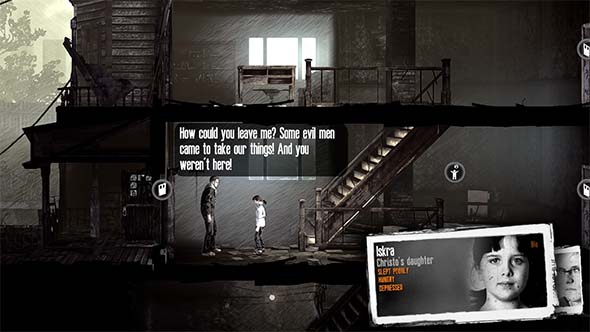
If the game wasn't already difficult and depressing enough, now you have to keep children safe as well.
The trauma of war
Children can be both a burden and a blessing in this game. By default, they can't perform most crafting, they can't shovel away rubble or unlock blocked doors, they can't be sent out to scavenge at night, and they can't do anything to guard or protect the shelter from raids. At the start, they are basically just extra mouths to feed that have the potential to consume more of your valuable medicines and bandages, but they can't contribute directly to your survival. They can also be particularly needy, and their needs can be tough to meet as you struggle just to get the basics like food, water, and an assembly line of crafting stations.
However, it won't stay like this for long, as children can be taught to do many of the same crafting tasks that the adults can do... [More]
7f046816-2d50-4dbe-8958-7c140325ddb6|0|.0
Tags:This War of Mine, This War of Mine: the Little Ones, expansion, DLC, PC, Steam, 11-bit studio, indie gaming, strategy, children, family, war, siege, refugee, civilian, survival, rogue
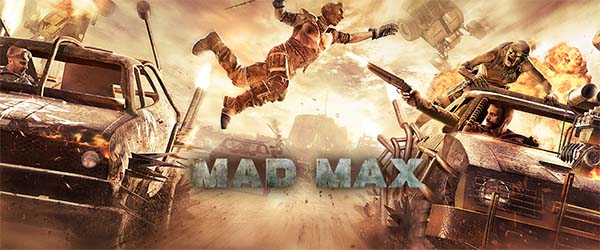
Normally, I try not to get excited about movie-tie in games. They have a very bad track record - with only a handful of exceptions. But this Mad Max game wasn't a direct movie adaptation, and it didn't release simultaneously with the movie, implying that it hopefully wasn't being rushed out the door to meet the movie's release. Warner Brothers Interactive had previously released Middle Earth: Shadow of Mordor, which was also sort of a tie-in to the Lord of the Rings and Hobbit movies, and that game was actually very exceptional! It had a novel and innovative concept around which the entire game revolved (making it very focused), and it was a very well-polished game that was immensely comfortable to control. So Warner Bros had earned some benefit of the doubt for its next game. I wasn't expecting Mad Max to match (let alone exceed) Shadow of Mordor, but I still had hopes that this one would turn out to be a well-realized game that could stand tall and proud as one of those rare, good movie tie-in games. After all, the concept of an open-world, post-apocalyptic action game about smashing spiky, nitrous-fueled cars into each certainly sounds like a solid premise for a game!
Well, not quite...
Wasteland chaos
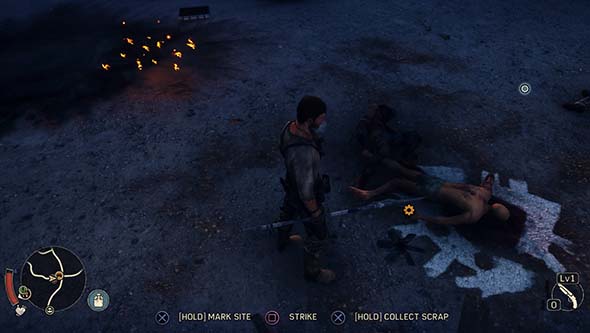
Many actions are overloaded to the X button - the game even displays conflicting prompts at times!
Virtually every interaction that I had with the game was either naggingly uncomfortable in some way or was prone to glitches. Even the basics of moving around and interacting with objects in the game world was a constant chore. When one button does everything; it does nothing (see my Assassin's Creed III review). Fortunately, a couple really important functions (like getting in and out of cars) were mapped to different buttons, but virtually everything else uses the X button. So if you're standing in front of a ladder and holding a weapon, it's a crapshoot whether the game will decide to let you climb the ladder or make you drop the weapon, and then it'll be a crap shoot whether the game lets you pick up the weapon again. Oh there's button-prompts to tell you what you can and can't do, but sometimes they outright conflict with one another. Besides, when you're running or fighting, then you're reacting on impulse and muscle memory rather than reading screen prompts. It doesn't help that the character's movement is very fidgety, so it's hard to position yourself properly when trying to interact with objects. I think the developers recognized this, which is probably why they make you have to hold the button for a second in order to perform most actions - to give you time to ask yourself "are you sure this is the action you want to do?".
Not enough space for vehicular combat
Clunky movement isn't limited to walking on foot. Steering vehicles is also very fidgety and floaty, and I found it very difficult to perform any precision maneuvering in the cars. The cars all tend to understeer at high speeds, but then strangely oversteer or fish-tail whenever you let off the gas. Trying to hit a ramp or knock down an enemy scarecrow or ram a sniper tower would often require multiple passes in order to succeed, and doing slaloms through the canyons resulted in a lot of cheap impacts. The rough terrain also leads to a lot of spin-outs. The vehicles feel so weightless and floaty that they can park on nearly vertical slopes, and running over a pebble can send the car hurtling and flipping 20 feet in the air. On a more personal note, I prefer my driving games to have cameras very close to the action, and so Mad Max's driving camera feels like it's a mile away from the action, which makes it harder for me to get a feel for precisely where the car is in relation to the environment. Virtually none of the game's vehicular set pieces really worked all that well for me due to these nagging control and scaling issues. If the map were bigger to accommodate multiple vehicles running side-by-side on a road, then dealing with the low-traction sand or the unlevel rocks wouldn't be so much of a consistent problem. Even having the option to zoom in the camera (an option that I couldn't find) would go along way towards helping me make more precise maneuvers.
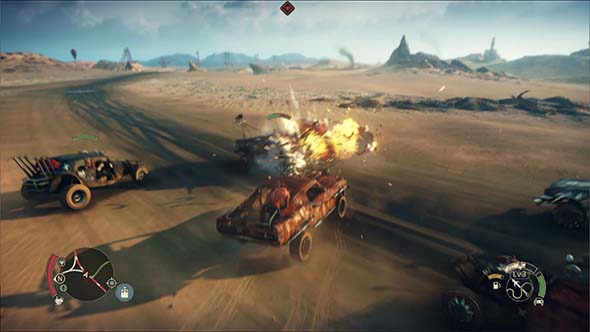
The primary gimmick of vehicular combat works fairly well in spite of the map not feeling big enough to support it.
This game really lives or dies based on how well the cars perform. The bulk of the game is played from within your car. You use the car to travel the world, and it's actually your primary weapon thanks to the game's novel vehicular combat. This vehicular combat would actually be really fun if the cars handled a bit better and were durable enough to actually take the beating that the combat entails... [More]
0acf283b-cb76-4ee2-80ba-14aaf6805d1e|0|.0
Tags:Mad Max, Max, Warner Brothers Interactive Entertainment, Avalanche Studios, vehicle, car, driving, combat, gasoline, water, wasteland, open world, sandbox, action, survival, fuel, food, post-apocalypse, nuclear war, Australia, Max Rockatansky, Chumbucket, Mad Max: Fury Road, movie tie-in, Achievement unlocked
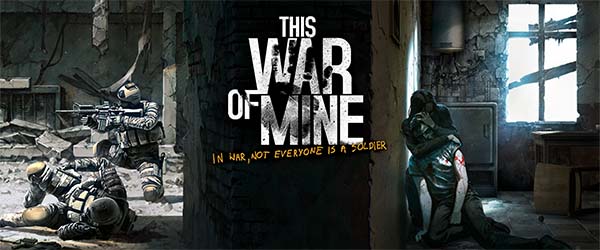
Games have an awkward relationship with war. Most games embrace violence and conflict because they are very easily simulated by computers and mapped to a set of easy-to-understand mechanics. Computers aren't as good at understanding or reacting to speech or emotion as they are at allowing a character to move around in a space and at tracing the path of a bullet or artillery shell. So when a game is about war, it's almost always told from the perspective of a soldier, someone actively participating in the war. And that character's participation is usually presented as noble and honorable, with the people that you are shooting being given little - if any - humanization at all. In many cases, the games will go out of their way to de-humanize the player's opponents by presenting them as literal demons, aliens, or the so-easy-to-hate Nazis.
While there are plenty of examples of games that deal with the behind-the-scenes causes and effects of a war, or the politics of conflict, these elements very rarely appear as central gameplay elements (outside of grand strategy games like Civilization, Total War, or Europa Universalis). Usually, the player plays on the battlefield, and any politics or effects beyond the battlefield are just material for non-playable cutscenes. At best, you might end up with a game that puts the player in the middle of the battle, but which has civilian characters that play a large role in the story.
One of my favorite games of the PS2-era is Ace Combat 4, which is a jet fighter combat game that found a comfortable middle-ground between flight sim and arcade shooter. Its narrative revolved around a child living in an occupied city, who befriends the ace fighter pilot of the occupying nation's air force. The player, however, takes on the role of a nameless, faceless ace fighter pilot belonging to the opposing liberation force. This created a fascinating dichotomy in which your success in missions resulted in defeats for the enemy ace who was the focus of the narrative. He falls into depression and alcoholism as the player systematically shoots down his wingmen and friends, and it served to humanize both sides of the conflict and exposed the human cost of war. One man's victory is the other's defeat. Your own victories became increasingly bittersweet as the game neared its final mission. It was a beautifully constructed scenario that has stuck with me to this day. I suspect that This War of Mine will leave a similar impact on me.
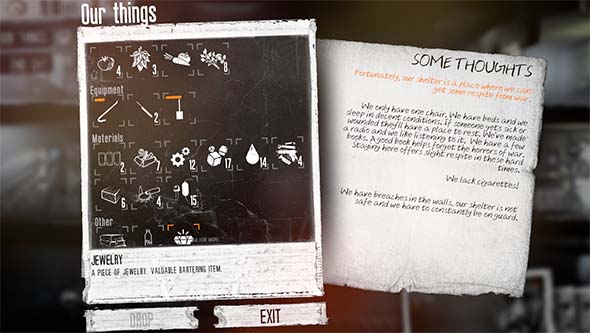
The logistics of keeping your shelves stocked with food and medicine is the primary challenge.
This War of Mine also reminds me of my visit to the Imperial War Museum in Manchester, U.K. this past January. I was really surprised by the difference in presentation that museum had as opposed to most museums that I visit in the United States. Whereas a museum in the U.S. will focus on exhibits of weapons, uniforms, vehicles, battle tactics, and politics behind wars, the IWM was focused primarily around the civilian costs of the two World Wars. It featured exhibits about food and material shortages, how women had to work as battlefield nurses and in factories, and how supplies were moved between cities under siege. It presented the wars as much more personal and ignoble and focused on how it affected people's day-to-day lives, and how the majority of people simply had to live through it. That's the same approach that the Polish studio behind This War of Mine took for their survival game.
Behind the lines
This War of Mine doesn't take place on the front lines or the battlefields. Instead of controlling a soldier, you play as a group of survivors in a rebellious city under siege. You have found a shelled building that you have claimed as a shelter, and every night, you must send one of your group out to scavenge one of various sites around the city for food, medicines, and other supplies to enable your group to [hopefully] survive till the end of the war. In the meantime, those who stay in the shelter must contend with the risk of being raided by other survivors during the night and having your hard-earned supplies stolen from under your own nose - or worse: somebody being hurt or killed.
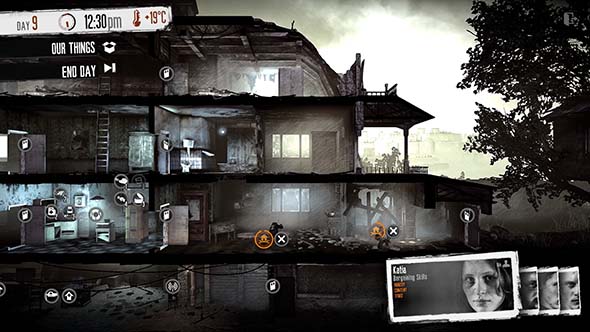
Your close-knit group of survivors must build and defend a shelter and scavenge for supplies.
The result is a game loaded to the brim with choices and consequences. How do your survivors spend their daytime hours? What items do you attempt to craft from your middling inventory of supplies? How do you defend yourself from raids? Do you send your one gun out with your scavenger in case he runs into hostile bandits, or keep it at home to defend your shelter from raids? Who do you send out each night to scavenge? Where do they go? And what do they bring back with them? The "rogue-like" fashion of the gameplay means that there's no undoing and no retries. This, combined with the scarcity of resources, makes every choice, every action, and every death is permanent. This gives a great deal of weight to all those choices that the game gives you.
... [More]
86d552ea-8fe5-4968-9a7d-1d98afbd4919|2|5.0
Tags:This War of Mine, PC, Steam, 11-bit studio, indie gaming, strategy, war, siege, refugee, civilian, survival, rogue

Although not a terrific game, the indie survival adventure game Miasmata (developed by Bob and Joe Johnson of IonFX) is an interesting title that does deserve to be played by its target audience. It's not a particularly challenging game, but players can back themselves up into seemingly insurmountable holes. Knowing the game's mechanics and rules - and knowing them early - is important to ensuring that you aren't forced to restart from the beginning or give up entirely.
Like with my previous strategy post for Alien Isolation, I am not going to provide specific walkthroughs for the game or any of its specific set piece challenges. In fact, doing so would be even harder than in Alien because Miasmata is a completely open-ended sandbox game. Instead, I will be offering some general-purpose tips that should be relevant for the entire game. This will include some techniques for working around the game's bugs and odd design flaws.
Owl statues point towards a cache of medicinal plants, but they do not count as landmarks or show up on the map.
This should be a pretty obvious tip. If you find the plants that are used for the 3 parts of the cure, or the three emphasis drugs, you should immediately pick them and ... [More]
12a74aef-1703-47e6-97c5-527408d0f4fe|1|5.0
Tags:Miasmata, IonFX, Bob Johnson, Joe Johnson, Steam, indie gaming, survival, action, adventure, horror, island, science, laboratory, specimen, sample, chemistry, map, compass, cartography, triangulation, torch, night, hallucination
|

| 12 | | | | | | | 60 | | 11 | | | | | | | 55 | | 10 | | | | | | | 50 | | 09 | | | | | | | 45 | | 08 | | | | | | | 40 | | 07 | | | | | | | 35 | | 06 | | | | | | | 30 | | 05 | | | | | | | 25 | | 04 | | | | | | | 20 | | 03 | | | | | | | 15 | | 02 | | | | | | | 10 | | 01 | | | | | | | 05 |
|